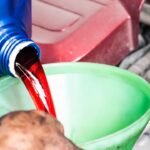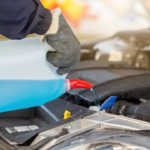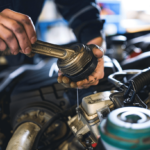Summer is a time for fun road trips, but don’t forget that safety should always come first. Before you hit the road, it’s essential to check your car safety equipment to ensure that everything is in working order.
Neglecting your car’s safety equipment can lead to dangerous situations and costly repairs. Here are the top 5 most common mistakes people make when it comes to car safety equipment during summer:
Table of Contents
Mistake #1: Not Checking Tire Pressure Regularly
Tire pressure is crucial for your car’s performance, especially during summer when hot temperatures can cause tire blowouts. Over-inflated or under-inflated tires can also affect gas mileage and vehicle handling, making them more challenging to control on the road. Checking tire pressure should be done at least once a month using a tire pressure gauge.
The recommended tire pressure is usually indicated in your car manual or on the driver’s side door jamb sticker. Don’t rely on the visual appearance of tires as they may look fine but still be underinflated or overinflated.
Mistake #2: Neglecting to Replace Worn-Out Windshield Wipers
Windshield wipers play a vital role in visibility while driving, especially during summer storms and heavy rain showers where visibility can be low. Worn-out wipers reduce visibility and can also scratch windshields which can lead to costly repairs.
It’s recommended that windshield wipers be replaced every six months or sooner if there are visible signs of wear such as streaking instead of cleaning windows correctly. When replacing windshield wipers, be sure to choose ones that fit your car model correctly by checking with an auto parts store or dealership for recommendations.
Why Tire Pressure is Crucial During Summer
Tire pressure is one of the most important factors to keep in mind when it comes to car safety equipment during summer. The hotter the weather, the more your tires will expand, and if they’re already at an insufficient level of pressure, they could blow out while you’re driving.
This is not only dangerous but also expensive and inconvenient to deal with. Additionally, proper tire pressure ensures better fuel efficiency and handling while driving.
Tips on How to Check Tire Pressure and Maintain it Properly
Checking your tire pressure regularly is simple and fast with the right tools. You can use a tire pressure gauge or go to a nearby gas station that offers this service for free or at a low cost. Make sure you check all four tires and that they meet the recommended level according to your vehicle’s manual.
In addition, it’s essential to maintain proper tire pressure by inflating or deflating them as needed. You should always do this when the tires are cold because hot tires can give inaccurate readings due to expansion.
It’s also crucial not only to rely on visual inspection since under-inflated tires could look just like properly inflated ones in some cases. By following these simple yet crucial tips, you’ll stay safe on the road during summer travels!
The Importance of Having Good Windshield Wipers During Summer Storms
Summer is a season that’s typically associated with fun in the sun, but it’s also a time of year when we’re more likely to experience severe weather conditions such as thunderstorms and heavy rains. When it comes to driving in these conditions, having good windshield wipers is absolutely essential.
Not only do they help to clear away raindrops and debris from your windshield, but they also play a crucial role in ensuring that you have good visibility while on the road. In addition to providing clarity of vision during heavy rainfall, good windshield wipers can also help to prevent accidents.
Visibility is key when driving, especially during inclement weather conditions where visibility can be greatly reduced. By keeping your windshield clear of water droplets or other debris, you’ll be able to react quickly to any sudden changes on the road and avoid potential collisions.
Signs That Indicate It’s Time To Replace Your Windshield Wipers
Windshield wipers are not meant to last forever and need to be replaced periodically in order for them to function optimally. The frequency at which you replace them will depend on several factors such as usage and exposure to harsh weather elements.
That being said, here are some tell-tale signs that indicate it’s time for you to replace your windshield wipers: 1) Streaking: If your windshield wiper blades leave noticeable streaks behind after wiping your windshield clean, then this is a sign that they may be worn-out or damaged.
2) Squeaking: If the blades of the wiper squeak loudly as they move across your windscreen , this might indicate that the rubber has hardened over time. 3) Skipping: If parts of your windscreen are missed while wiping – this could mean that there’s a buildup of residue on your blades or an issue with the tension or alignment of the wiper arm, which may require a professional to fix.
It’s important to prioritize good windshield wipers during summertime. Keep an eye out for signs that it’s time to replace them, and make sure they are in top-notch condition before hitting the road in stormy weather.
The Importance of Having a First Aid Kit in the Car
Accidents happen, and when they do, it’s essential to be prepared. A first aid kit should be an essential item in your car, especially during summer when you’re more likely to take longer road trips.
Whether it’s a minor cut or a more severe injury, having the right tools can make all the difference in preventing further harm and getting medical help when necessary. A first aid kit can help you handle emergencies such as bites and stings, burns and cuts or scrapes.
It also comes in handy for those with pre-existing medical conditions who need immediate assistance while on the road. When choosing a first aid kit, make sure to select one that is appropriate for your needs and consider any allergies or specific conditions that you may have.
What Should Be Included in a First Aid Kit?
A well-stocked first aid kit should contain all of the essentials needed to handle any emergency on the road. Some of these items include bandages of various sizes and shapes, gauze pads and adhesive tape for wounds, antiseptic wipes or ointment for cleaning injuries, painkillers like aspirin or ibuprofen for headaches or body pains, tweezers to remove foreign objects from skin as well as scissors for cutting bandages.
Other items that could come in handy during summer include sunscreen with SPF 30 or higher and bug spray/repellent. For people with allergies – especially those allergic to insect bites – carrying an epinephrine auto-injector is crucial.
While most commercially available first-aid kits come packed with essentials items like these mentioned above; it’s always wise to add extra personal medications such as allergy medication if needed. In addition to carrying a well-stocked first-aid kit in your car at all times this Summer; consider taking CPR training classes to be better prepared for emergency situations.
Don’t skimp on your brakes!
Brake pads and fluid may not be the most glamorous parts of your car, but they are some of the most important when it comes to safety. If your brakes aren’t functioning properly, you could be endangering yourself and those around you every time you get behind the wheel.
To keep your brakes in top shape, it’s essential to check them regularly. Brake pads should be inspected every 12,000 miles or so to make sure they’re not worn down too much.
You can also listen for squeaking or grinding sounds while braking, which can indicate that the pads are reaching the end of their lifespan. Additionally, if your vehicle pulls to one side while braking, this could also mean that one set of pads is more worn than the other.
The importance of brake fluid
In addition to brake pads, it’s crucial to check your brake fluid levels regularly. Without enough fluid in the system, your brakes won’t work at their full capacity and could fail completely in an emergency situation. To check brake fluid levels, pop open the hood and locate the reservoir near the firewall on top of the master cylinder.
The fluid should be within a quarter inch of the “full” line when cold; if it’s lower than that, add more until it reaches that point (being careful not to overfill). If you find that you have consistently low brake fluid levels over time, there may be a leak somewhere in the system – which should be addressed by a mechanic as soon as possible!
The Dangers of Overloading Your Vehicle or Roof Rack During Summer Road Trips
Summer is the perfect time to go on a road trip with family and friends. However, it’s essential to keep in mind that overloading your vehicle or roof rack can be incredibly dangerous.
When you overload your car, you’re putting unnecessary strain on the engine, tires, brakes, and other components of your vehicle. This strain can cause them to fail when you least expect it, putting yourself and other drivers at risk.
Not only is overloading dangerous for your car’s mechanical components, but it also becomes a serious safety issue during an accident. Any extra weight inside the car is unrestrained during an accident and becomes a projectile that can cause severe injury or death if it hits someone in the vehicle.
That’s why it’s crucial to follow manufacturer guidelines regarding weight limits for both passengers and luggage while traveling by car. It may seem like common sense, but many people ignore these guidelines and end up risking their lives on the road.
How to Determine The Maximum Weight
Determining the maximum weight limit for your car is a straightforward process that starts with reading your owner’s manual carefully. If you don’t have access to the manual or have lost it somewhere along the way, you can usually find this information online by searching for your car make and model with “weight capacity” added at the end.
It’s important to note that different vehicles have different capacities based on their size and structure. For example, smaller cars are typically not designed for carrying heavy loads compared to larger ones like SUVs or trucks.
When packing for a road trip, always make sure that you distribute weight evenly throughout your vehicle rather than piling all of your bags in one spot – such as stacking several bags on top of each other on top of a roof rack where they could easily topple over while driving. You should always strive to stay within the weight guidelines recommended by the manufacturer of your car for optimal safety and handling.
Conclusion
Driving safely is important, especially during summer road trips when you’re likely to be carrying a lot of extra gear. By avoiding common mistakes like neglecting tire pressure or failing to check brake pads and fluid levels, keeping a first aid kit in your car, replacing worn-out windshield wipers, and not overloading your vehicle or roof rack, you can keep yourself and others safe while enjoying your vacation. Remember that following these simple tips can make all the difference between having a fantastic summer road trip experience versus one that could end in tragedy.






